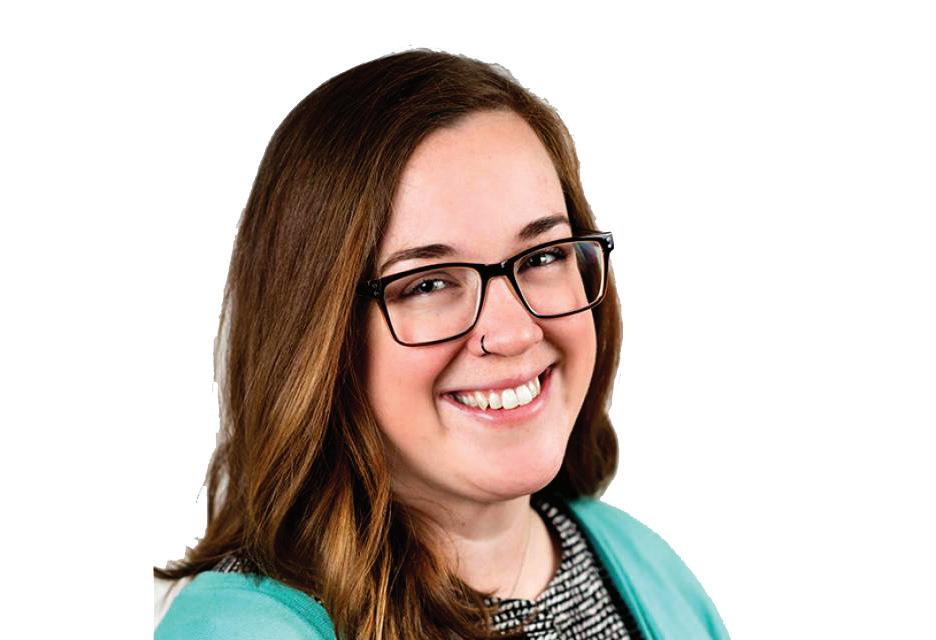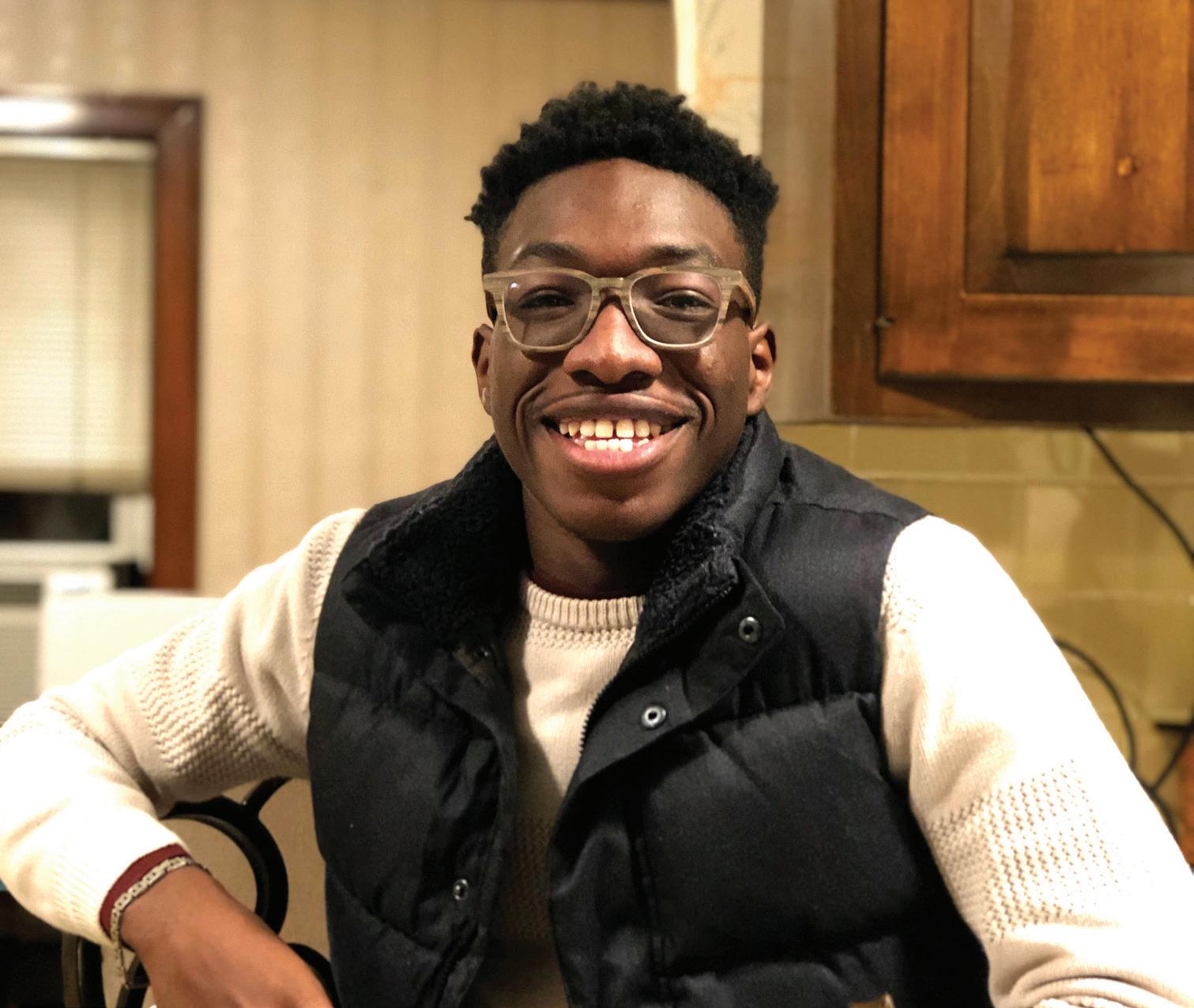
21 minute read
New: The Campus Program Planning Committee on Race (CPPCR
What is the CPPCR?
Springfield College’s brand new committee is here to better the campus.
Advertisement
By Irene Rotondo @irenerrotondo
It’s no secret that Springfield College attempts to have diversity and inclusion for everyone on its campus. However, many have felt and voiced their opinion that this is simply not the case. As Vice President for Inclusion and Community Engagement Dr. Calvin Hill stated in his email alongside President Mary-Beth Cooper, “It is past time for us to act, but act we must.”
Following that sentiment, the new Campus Program Planning Committee on Race was established with Dr. Hill heading it up. Though there are 17 initiatives outlined in detail in the aforementioned email, Hill stated that CPPCR’s overarching initiative was to make the campus a better place for Black, Indigenous, and People of Color (BIPOC) students.
“We understand that students that are exposed to diversity, students that speak about it and hear about it, both the majority students as well as BIPOC students alike, are going to be more likely to live in an inclusive and welcoming community, because these are things they are processing and thinking about.
“My hope, as a committee, we’re going to be able to introduce the community to areas we know that we need to be having a conversation on, areas of our country we know we need to be having a conversation on, and we can’t shy away from those difficult conversations. If we want our students to be better, if we want our students to understand the value of diversity and inclusion, it can’t be something that we don’t speak about,” added Hill.
The committee, born in the timeline of BLM, recognizes that in the admission of students to Springfield College from a diverse array of backgrounds, there is also an admission for the potential of dissent among groups. “We’re bringing students in, from New England primarily, that have not had an opportunity because of their segregated communities to interact in dialogue cross-culturally,” stated Hill.
“The reality for us is that when you bring people in from diverse backgrounds (socio-economically, spiritually, orientation-wise) tension is going to happen. So, what we want to talk about is how we engage, how we deal with tensions, understanding that tension is inevitable.”
Hill went on to explain that the committee also hopes to explore options within the classroom in forms of seminars and even an “Anti-Racism Class”. He believes that if students are exposed to issues that concern diversity and inclusion educationally, they are more apt to create that type of community around themselves.
CPPCR will also be working in tandem with the initiatives brought forth in 2017 by the Division for Inclusion and Community Engagement in regard to retention and admission rates of BIPOC.
Hill said that because of the nationwide involvement over the past few months concerning the Black Lives Matter movement, more people are going to be interested in helping. This will prove to be helpful in furthering the Campus Inclusion Plan from 2017 that has since lost its momentum.
“When I came to campus in 2015, I think it was during a time period where people were really excited, people were excited that this new position was here,” said Hill.
“But then, we start to see kind of a lull, a lot of the programs and a lot of the things that I had put on, they had had a lot of attendance and then we see the attendance kind of slow until it became kind of normal that we were doing these things. But now, you know the attention is going to be back focused.”
The Campus Program Planning Committee on Race is yet another step Springfield College has taken in the right direction on the road to anti-racism. As always, there is more work to be done, but the programs and conversations that will ensue because of CPPCR will be an invaluable experience for the community.
News NSO at a distance
Coronavirus and masks did not stop the NSO leaders from putting on a good event for the first-year and transfer students.
By Collin Atwood @collinatwood17
When someone looks in at Springfield College from the outside, they immediately notice two things: Springfield College is the birthplace of basketball and spirit, mind and body are very important to the school’s philosophy. It’s when people get on campus they realize that there is something else just as important to the school when you become a part of the campus community.
That something is tradition.
Dating all the way back to 1885 when the school was founded, Springfield College has been known for its traditions. From freshman beanies to midnight bingo, the college has been committed to upholding the standard of their traditions.
Even not walking across the grass is a written tradition at the college which symbolizes not cutting corners in school or in life.
The one that stands above the rest at Springfield College is New Student Orientation (NSO).
NSO is held the weekend before classes start and is meant to help the freshman and transfer students get to know the school’s policies, guidelines and most importantly, each other.
“It was a great transition from high school,” said Skylar Steele, a sophomore at Springfield College.
NSO is very important in showing the new students what Springfield College is all about. Students learn a lot over that weekend. They are shown how valuable the Humanics philosophy is and how to truly embody the spirit, mind and body.
“It’s just a great way to be a part of Springfield College and we
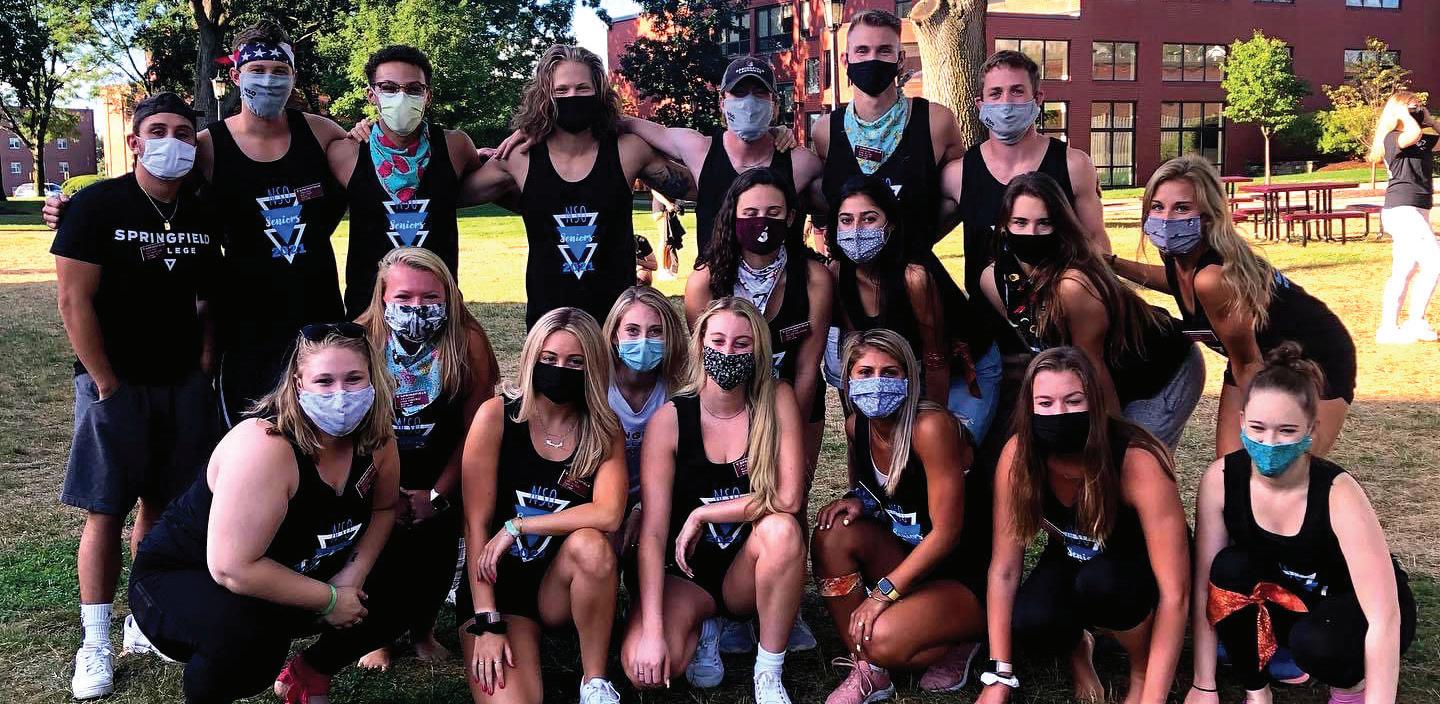
always try to infiltrate what it means to be a student here,” said NSO leader Hannah Barnes, a junior at Springfield College majoring in Occupational Therapy.
NSO has its own traditions within itself that students and leaders always look forward to. Some of the more popular ones are the banquet, learning the college’s chants and participating in the Humanics in action day.
This year NSO weekend took place from Aug. 28 to Aug. 30. Unfortunately, the COVID-19 outbreak caused some difficulties that the new students had to adjust to.
“It was weird... obviously we’re not used to having to do anything like this in our lives,” said Jack Jeffrey, a freshman at Springfield College studying Communications and Sports Journalism.
No one at the beginning of the year would have thought that during NSO everyone would have to meet their future lifetime friends without seeing half of their face.
“You don’t really get to see the people you’re meeting or see the people you’re talking to,” said Madison Daly, a freshman on the women’s soccer team. “Everyone just looks the same because everyone just has a mask on,” she added.
There were also some events that the new students had to miss out on this year. The
Despite coronavirus restrictions, first-year students and transfers still got to spend quality time with their NSO groups. (Photo Courtesy of Collin Atwood/The Student)
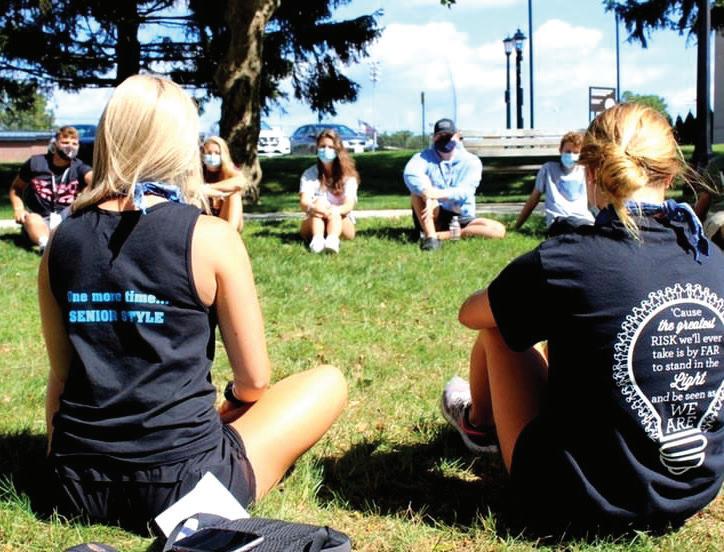
hypnotist, movie night, banquet and the Humanics in action day were all cancelled this year.
Even though there were many changes to the normal NSO schedule, the new students of Springfield College still got to have an unforgettable experience.
“It didn’t feel a whole heck of a lot different,” said Lydia Sinkiewicz, a senior at Springfield College who has been an NSO leader for three years. “All of the incoming first years were able to still have a very similar experience to what a typical NSO would be like,” she added.
Normal NSO rituals still happened, just with some modifications. Usually every group has different students from all different dorms. This year the groups were filled with people that were on the same floor.
The problem with this is that it stops students from being able to venture out to other buildings to make new friends. On the plus side, it helps them grow closer to the people who they will share a floor with for a whole semester.
Most activities had to be done with social distancing rules, but that doesn’t diminish the value of them. Some activities that are vital when getting to know each other, like fear in a hat and circle of support, still happened and had just as much of an impact as they did any other year.
“Despite all of the crazy changes, it honestly was my best orientation experience ever,” Sinkiewicz said.
The goal of NSO was still the same this year and that goal was achieved through adversity. The new students were able to meet new people, make everlasting bonds and truly see what it means to be a member of the Springfield College community.
“This is probably going to be one of the most memorable NSO weekends in Springfield College history,” Barnes said.
Arruda: I am lost and I’m not even an athlete
A sports-less campus effects more than just the student-athletes and coaches themselves.
___ By Joe Arrud @joearruda9
When Springfield College announced that there were not going to be any intercollegiate athletic competitions this fall, I was devastated. I shared the news on Twitter as I helped set up a graduation party for one of my good friends who was unable to walk the stage in a typical graduation ceremony. While taping down table cloths and hanging decorations, all I could think about was what this semester would look like. Before being sent home early in the spring semester, I was busier than I’d ever been. It was my first semester as the “Sports Editor” for The Springfield Student and I was simultaneous- ly completing my first internship as a high school sports reporter for The Daily Hampshire Gazette. The semester started off in Blake Arena with the grind of covering Hoophall, and ended on the same hardwood covering the “Birthplace Boys” run in the NCAA tournament. I had no free time on my hands, but it was just the way I wanted it. Live sports were such a major part of my college life – their schedules determined mine. Being back on campus without them, well, it is clear that not only my life has been affected. The whole campus vibe is off. Maybe it’s not just about the sports – the fact that you can’t see anyone’s face walking around campus might have something to do with it – but without that structure I am lost. I am lost, and I’m not even an athlete – I couldn’t even start to imagine what it would be like missing out on a senior season. There is a certain toll that this pandemic has taken on all of us. The sudden flip of the switch that put a pause on all of our lives, directly forcing us into a mental terrain that has never been discovered. Finding ways to adapt to the new environment, the masks and the rectangular “Zoom” screens, is the only way we can make it out. Obviously, it makes sense why we don’t have sports. I am not ignoring or downplaying the risks of the pandemic in any sense. Running a sports
Joe Arruda interviews Sidney Moncrief at the 2019 National Basketball Hall of Fame enshrinement. (Photo by Cam Smith)
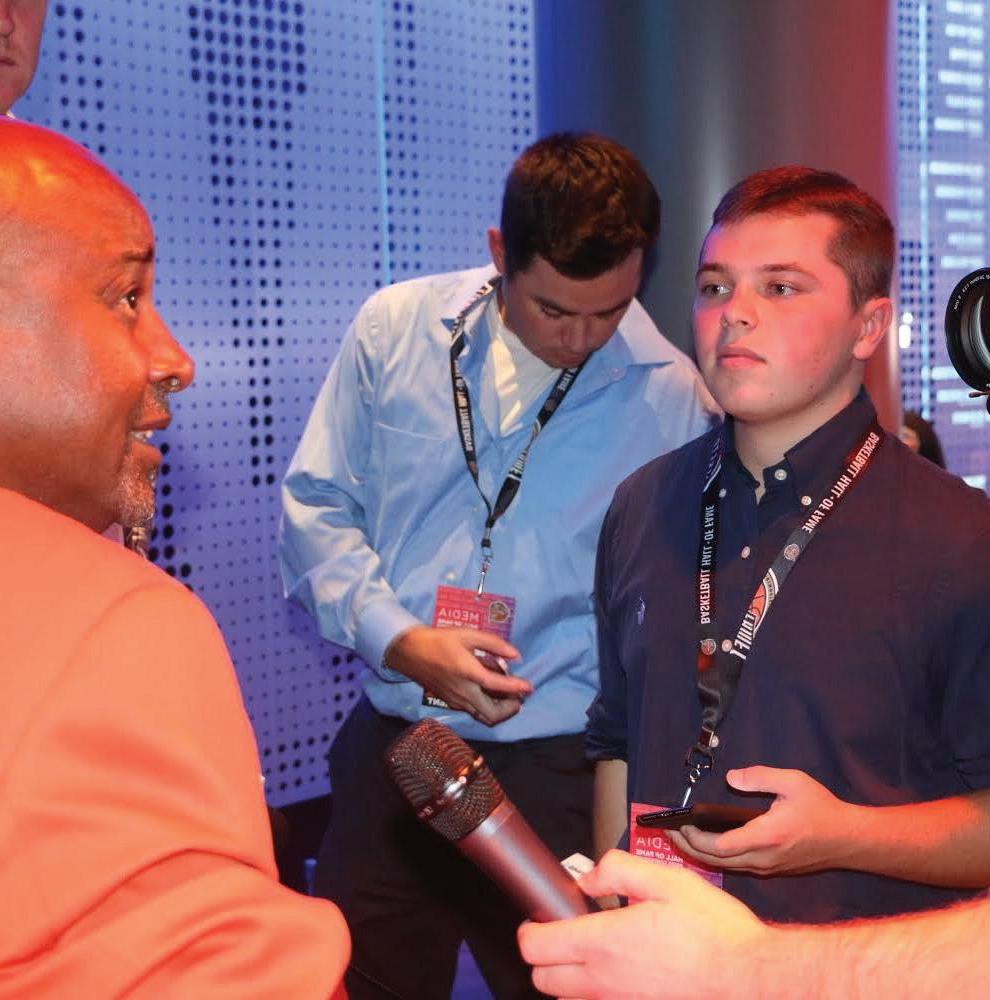
section without any live sports will be tough, and it already has been. I am tired already of having every story have to do with the fact that things are different – that something is missing. But it is a new challenge. An opportunity to take it slow and to learn while still providing quality sports content for our readership. Just because there aren’t intercollegiate sports competitions on campus doesn’t mean that there aren’t still stories. Everyone has a story that is waiting to be told, and I am here to share them. So while I was looking forward to taking over the football beat this fall, I am still excited for the challenge of digging deeper and finding something behind the masks. Almost one-third of the Springfield College student body are student-athletes (31 percent, according to the College’s website), and not only that one third are missing sports. I think about how many people came out and packed Blake when the men’s basketball team played against Hobart in the NCAA tournament, or how many were there to watch the men’s volleyball team earn their revenge against No. 1 SUNY New Paltz. It is sadness. It is devastation. But it is a time to discover new terrain.
(Joe Arruda/The Student)
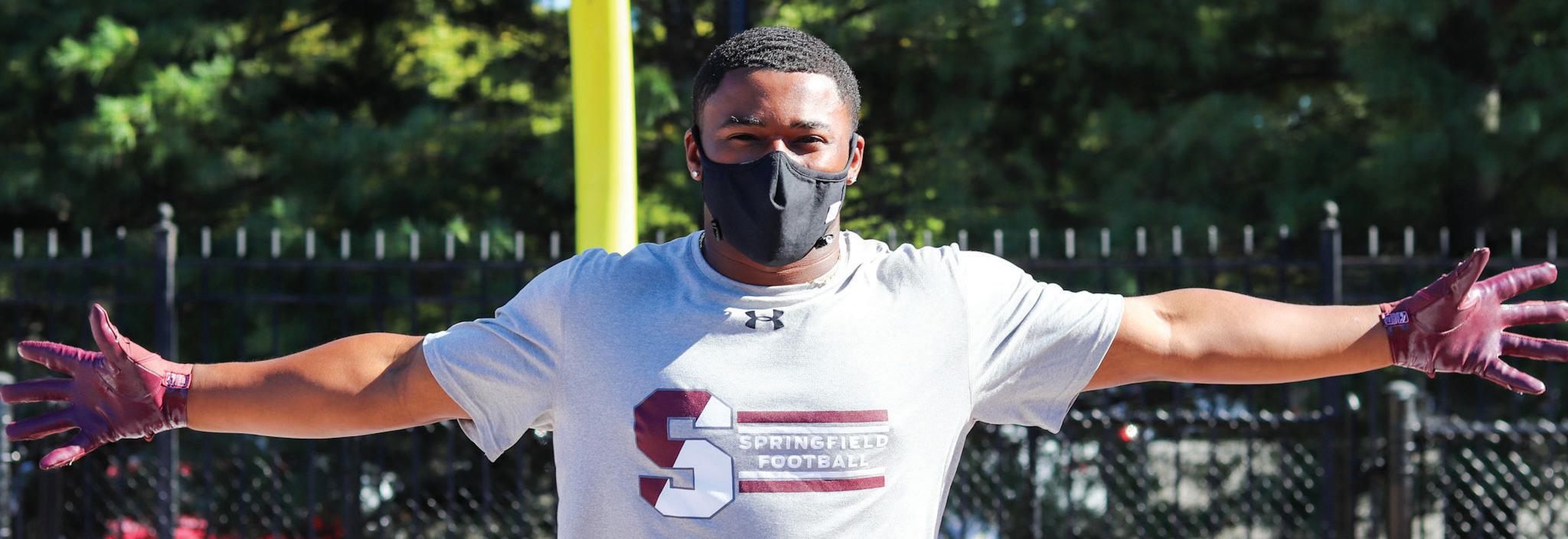
Cashwell-Doe: It felt like a living hell
After working as a nurse and contracting the coronavirus, Springfield football’s Isaiah Cashwell-Doe was forced into isolation in his home.
__ By Isa ah Cashwell-Doe __ @isdoe_6
My name is Isaiah Cashwell-Doe and I am a rising junior as well as a member of the football team at Springfield College. When I was asked about being sent home due to the Coronavirus, I feel like it brought back a certain type of PTSD for me. I am the type of person who excels best when around people, so having to stay home trapped in my room brought back my depression and anxiety really bad. To a point, I truly didn’t know how to control the emotions, and I haven’t felt like that since junior year in high school when I was having suicidal thoughts. But then, an opportunity to become a nurse during quarantine came knocking at my door… I could not deny that opportunity. Having the ability to socialize again with people other than my family, and having the opportunity to help people, felt amazing. Unfortunately, within two weeks of working as a nurse, I had tested positive for the coronavirus. Getting that phone call from the hospital and them saying “Isaiah Cashwell-Doe, you have tested positive for the coronavi- rus”... it felt like the world stopped, the first time in my life where I had been speechless. And all over again, I was stuck in my room – the only place I could go was the bathroom. My parents fed me from the door, and the only way to commu- nicate was through a cell
(Danielle Schmelling/The Student)
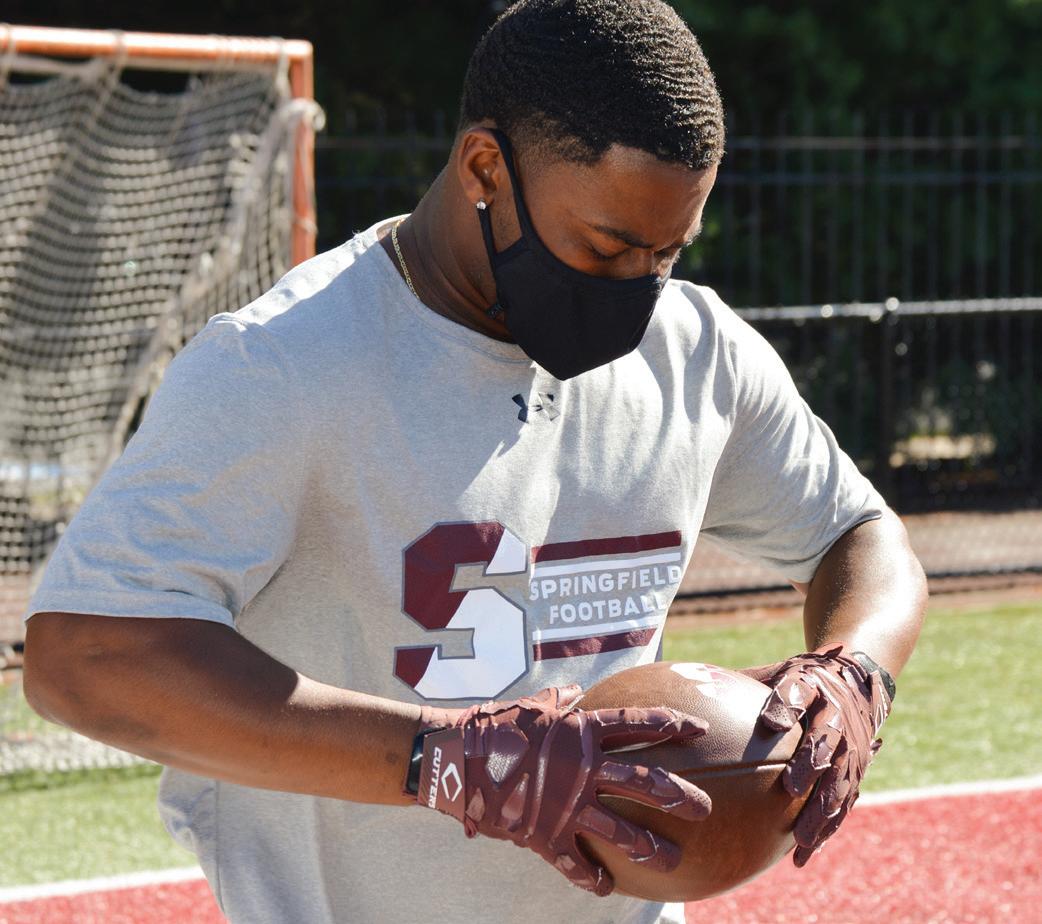
phone. For an extrovert, it felt like a living hell. Ten days later I felt free. I was able to attend work again and do what I love best, putting smiles on people’s faces. Now, being a nurse through this time… it might have been the hardest thing I think I have gone through emotionally. Every day a patient would pass away and the more I was there, the more it hurt me seeing my patients pass and the fam- ilies not even having the opportunity to see them. That being said, these past few months have been extremely stressful, but it has made me grow. I had the opportunity through it all to learn how to truly love myself, even with the flaws in my life. Mentally I feel stronger than ever. Coming back to school I honestly feel the best I ever have mentally. Then, for this semester, this is a great opportunity for me to grow even more. This is a time for me, along with other members of Springfield College, to find out what we are truly passionate about. Lastly, a chance to excel in school, with sports being canceled for the semester this a big time for the school to put 110 percent into learning.
Athletes without sports
___ By Tyler Browne ___ @T_Browne1124 In a typical fall semester, the first week on campus would end with the first football game of the year. Students would pack the bleachers of Stagg Field to watch the Pride begin another campaign. Throughout the week, the other fall sports teams would begin their seasons as well. From mid-afternoon through early evening, students could walk down the sidewalk on Alden Street and hear the cheers coming from Stagg, Brock-Affleck Field and Blake Arena. However, this is the fall of 2020, where nothing is normal. On July 17, Springfield College President Mary-Beth Cooper and Director of Athletics Craig Poisson made the difficult decision to cancel intercollegiate athletics for the fall semester, out of concern for the health of students and coaches amidst the ongoing COVID-19 pandemic. For the athletes who make up these teams, this announcement was expected but met with disappointment. For Heather Fontaine, this disappointment began in March, when Dr. Cooper first announced that the College would be moving to remote learning. “When school first went remote back in March,
Left to right: Heather Fontaine, Hunter Belzo and Camryn Bancroft. (Photos Courtesy of Springfield Athletics)
I was very disappointed that we would not have a spring track season. I did feel very confident that we would be able to compete come fall season, obviously not knowing at the time how the virus was going to take its course,” said Fontaine, who is also a member of the cross-country team. “I really started to wonder if we would be able to compete this fall when Governor Baker began reopening the state of Massachusetts. As we were going through the phases [of reopening], it seemed like it was moving slower than what people had originally assumed - again not fully understanding the virus’s course of action,” said Fontaine. While administration made it clear that they were working to find ways to allow for students to return to campus in September, there was no official word on athletics until an email was sent out in mid-July from Cooper and Poisson, explaining the decision to cancel the fall season. By the time of the announcement, some athletes had already begun to expect the worst. “I was optimistic that we would still be able to compete in some sort of way, but I was realistic that it wouldn’t look like all our seasons before...In the middle of July I started to doubt our return to a normal season, all the big schools and the NCAA were having big meetings and canceling seasons, so I had a feeling that we wouldn’t have much of a season or even one at all,” said Camryn Bancroft, a senior on the women’s volleyball team. “When I first started seeing on Twitter that conferences began to cancel, I kept checking every day, like, ‘they’re probably going to cancel us next.’ So I started checking everyday once conferences started cancelling and then when they cancelled us it was just all so crazy,” said Hunter Belzo, a fifthyear senior on the football team. Belzo and Bancroft both lost more than just their final season with the Pride. They each had their season cut short by an injury last fall, not knowing that they had played their last collegiate game. “I was really upset [when they cancelled the season]. My [junior] season was cut short due to a season ending stress fracture and now my senior season was canceled as well. Not at all how I want to end my career at Springfield,” said Bancroft. Upon learning of the cancellation, Belzo reached out to Chad Shade, the team’s quarterback, who was also returning for a fifth-year. Although he considered taking the year off and finishing school in 2021, Belzo decided to finish his collegiate experience this semester. “If I want to come back to the team, I’ll go to grad school or something like that. I just don’t want to keep pushing back my degree. I was supposed to graduate this past spring, but I saved credits so I could play this fall...I’ll worry about football later.” The absence of sports also marks a major change in the lifestyle of fall athletes. Belzo has chosen to take his classes remotely from home, but there has been quite a difference in campus life for athletes living in dorms, especially with practices on hold for the first two weeks of the semester. “It’s been weird not having anything during that 4 p.m. time slot, but it’s been good to get adjusted to this new normal during this time without practice. I’ve still been able to run with a few of my teammates, socially distanced of course,” said Fontaine. “I’m very happy and grateful to be back on campus but honestly, it’s very boring without practice or being able to compete with my team... The only thing that keeps driving me to be better is knowing we can be back in the gym in a week and finally get to touch a ball and play with my teammates. “The feeling of being on the court with your teammates and watching everything you’ve been working for the whole week in practice, that’s what I really miss the most,” said Bancroft.
Football head coach Mike Cerasuolo looking on as his team played against WNE fall 2019. (Jack Margaros/The Student) ___ By Chris Gionta ___ @Chris_Gionta Not one has gone through the last six months without making compromises, and that is now especially true with the fall athletes and coaches at Springfield College. On July 17, Springfield College President MaryBeth Cooper announced that the school would not be involved in any intercollegiate athletic competition. Since then, coaches have been preparing for an exclusively intrasquad fall season, while also adjusting to new limits and restrictions for general safety. “At the moment, we’re in groups of ten, and they have to be six feet apart and wear masks,” said John Gibson, the head coach of the Springfield women’s soccer program. “Then we hope if everything goes well that restriction will be off.” Unlike a normal season, conditioning may have to take a back seat to technical work for the first couple of weeks, rather than the other way around. “It’s going to be much more of a skill focus initially than it normally is at this time of year,” said Melissa Sharpe, the head coach of the Springfield field hockey team. The coaches also recognize that their athletes are likely at different levels of readiness due to the quarantine, and they realize that every individual had differing circumstances. “The first two weeks, our priority is just trying to get the kids back acclimated to different running mechanics and techniques, and seeing what type of condition and shape that we might be in,” said Mike Cerasulo, the head coach of the Springfield football team. “Because everybody was under different circumstances during the last 6-8 months or however long we’ve been doing this for. Some guys had all the equipment they needed, some guys had very little, some guys had none.” Without intercollegiate competition, the perception is that there is no end goal. This is partially true, and the coaches are aware of that, but they take it as a challenge. They must find new methods to motivate their athletes and keep it competitive. “For us, it’s finding ways to be creative as coaches, and it’s implementing different types of training, different types of drills -- things that are going to look really different to the players -- trying to mix it up frequently so it’s not just the same old routine, and it’s, in a good way, somewhat unpredictable for them,” said Coach Sharpe. “But also, I think a big piece of that is finding ways to create competition within a practice.”
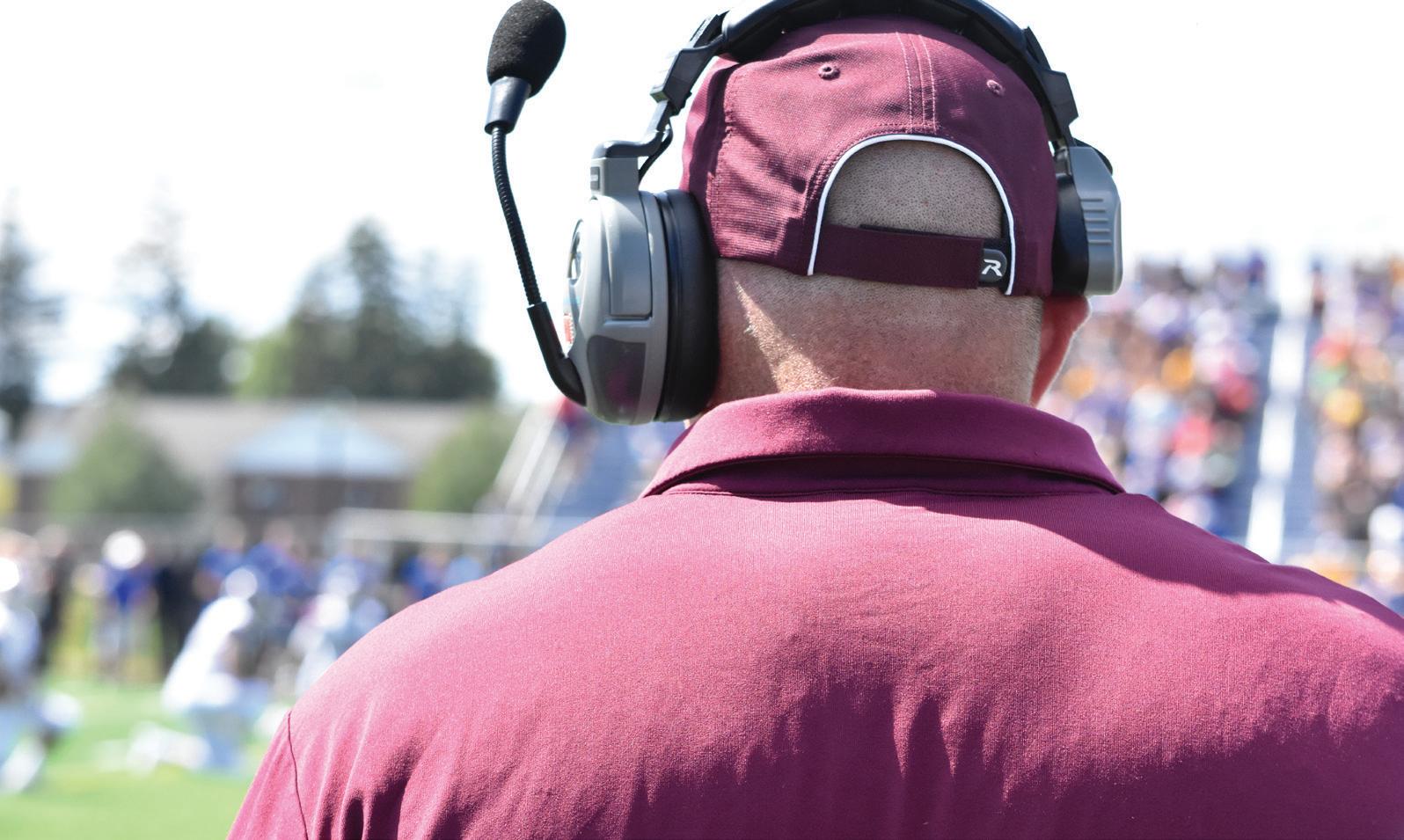
What are the coaches doing?
For many athletes, especially underclassmen, the motivation must be maintained even without competition, with sights on future seasons. Cerasulo is aware that this is not a lost season for everyone involved. “Motivation [for the players] to me is pretty easy,” he explained. “Because at some point, this is going to all change and so we’ve got to be ready to play, and our kids understand that, and they want to play, so they’re working every day for the opportunity for that to happen. We don’t know when that might happen. Hopefully we have the opportunity to have a maroon-onwhite scrimmage at some point during the fall. If not, potentially there’s something in the spring. If not that, we’re definitely, hopefully going to play in the fall.” Younger players can surely benefit from this new athletic experience, as it gives them more repetitions to craft their skills for the future. Attempting walk-ons will also face newer, and possibly more beneficial challenges in their pursuit to play for the Pride. “We have some kids that are kind of in a situation where they’re being looked at to try out,” Sharpe said. “And so, giving them scenarios where they can be successful and show their competition level as well I think is going to be very needed.” The 2020 fall sports season will undoubtedly be incomparable to any other collegiate athletic season that has been experienced thus far. The initial feeling towards it is negative, but people may take some unexpected positives from it. Since this has never been done, all anyone can do is wait and see.

